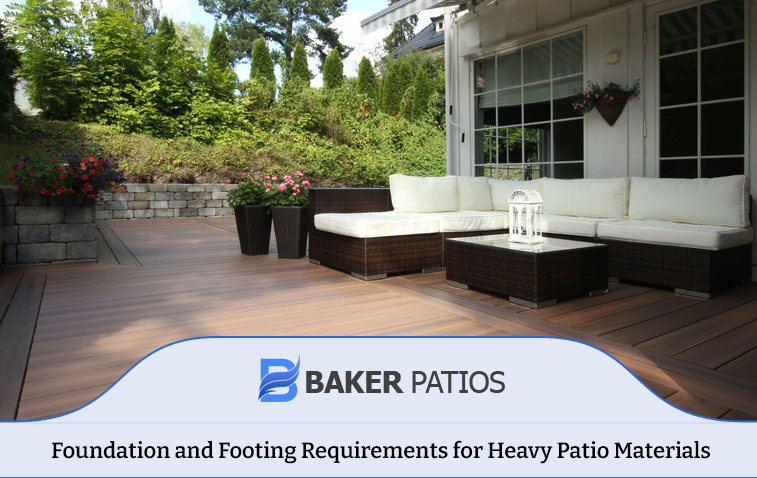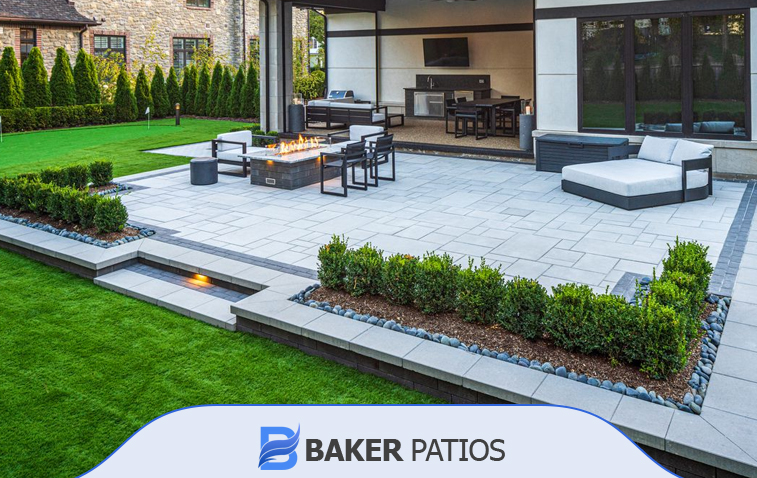Foundation and Footing Requirements for Heavy Patio Materials
How do you feel like walking onto a beautiful patio. It’s sturdy and level and the materials are heavy and impressive. But what keeps it all in place? The answer lies beneath your feet. A strong foundation and proper footings are the unsung heroes of any patio. They support the weight and keep everything stable. Without them, even the most beautiful patio can sink or crack. This is especially true for patios made with heavy materials like stone or concrete. Building a patio isn’t just about what you see on top. It’s about creating a solid base that will last for years. In this guide, we’ll explore what it takes to build a strong foundation for heavy patio materials.

Understanding the Basics of Foundations and Footings
Let’s start with the basics. What are foundations and footings?
A foundation is the base that supports a structure. For a patio, it’s usually a layer of compacted gravel or concrete. This foundation spreads the weight of the patio evenly across the ground.
Footings are part of the foundation. They’re like the feet of your patio. Footings go deeper into the ground. They anchor the patio and prevent it from shifting.
Together, foundations and footings do important jobs:
- They support the weight of the patio materials
- They keep the patio level
- They prevent sinking or settling
- They protect against frost heave in cold climates
For heavy patio materials, these jobs are even more crucial. Stone, brick, and concrete are weighty. They need extra support to stay in place.
Types of Heavy Patio Materials
Before we dive into foundation requirements, let’s look at some heavy patio materials:
- Natural Stone: This includes materials like slate, granite, or limestone. Natural stone is beautiful but heavy.
- Concrete Pavers: These are pre-made concrete blocks. They come in many shapes and sizes.
- Brick: Clay bricks are a classic choice for patios. They’re durable but can be quite heavy.
- Poured Concrete: This creates a solid, seamless patio surface. It’s very heavy when cured.
- Tile: Some outdoor tiles, especially thick ones, can be surprisingly heavy.
Each of these materials has its own weight and characteristics. This affects the kind of foundation they need.
Factors Affecting Foundation Requirements
Several factors determine what kind of foundation your patio needs:
- Soil Type: Different soils support weight differently. Clay, sand, and loam each have unique properties.
- Climate: Freeze-thaw cycles can affect foundations. Areas with harsh winters need deeper footings.
- Patio Size: Larger patios need more substantial foundations.
- Material Weight: Heavier materials require stronger support.
- Intended Use: Will you put heavy furniture or a hot tub on the patio? This adds more weight.
- Slope of the Land: Building on a slope requires special foundation considerations.
- Water Drainage: Proper drainage prevents water from weakening the foundation.
Understanding these factors helps in planning a suitable foundation.
Basic Foundation Types for Heavy Patio Materials
Let’s explore some common foundation types for heavy patios:
Compacted Gravel Base:
- This is a simple and effective foundation.
- It involves layers of gravel, compacted tightly.
- It provides good drainage and support.
- It’s often used under pavers or natural stone.
Concrete Slab:
- This is a solid concrete foundation.
- It’s poured as one piece.
- It’s very strong and stable.
- It’s ideal for poured concrete patios or large stone slabs.
Pier and Beam:
- This uses concrete pillars (piers) to support beams.
- The patio material sits on top of the beams.
- It’s good for elevated patios or uneven ground.
Frost-Protected Shallow Foundation:
- This is used in cold climates.
- It uses insulation to prevent frost heave.
- It allows for shallower footings in freezing areas.
Each type has its pros and cons. The choice depends on your specific needs.
Preparing the Ground for Your Foundation
Proper ground preparation is crucial. Here’s a simple step-by-step guide:
- Mark the Area: Use stakes and string to outline your patio.
- Remove Grass and Topsoil: Dig down about 6-8 inches.
- Level the Ground: Use a long, straight board and a level to check.
- Compact the Soil: Use a plate compactor to firm up the ground.
- Add a Landscape Fabric: This prevents weeds from growing up.
- Create a Slope: Ensure a slight slope away from your house for drainage.
Good preparation prevents future problems. It’s worth taking the time to do it right.
Footings: The Deep Support for Heavy Patios
Footings are crucial for heavy patios. They distribute weight and provide stability. Here’s what you need to know:
Footing Depth:
- In warm climates, footings should be at least 12 inches deep.
- In cold climates, they need to be below the frost line.
- The frost line can be 3-4 feet deep in some areas.
Footing Width:
- Width depends on the patio’s weight and size.
- A general rule is to make footings twice as wide as they are thick.
Spacing:
- Footings are usually placed every 6-8 feet.
- Corners and edges need extra support.
Materials:
- Concrete is the most common material for footings.
- Rebar or wire mesh can reinforce the concrete.
Remember, local building codes often dictate footing requirements. Always check these before starting.
Special Considerations for Different Materials
Each patio material has unique needs. Let’s look at some specifics:
Natural Stone:
- Needs a very stable base to prevent shifting.
- Often requires a concrete slab foundation.
- Drainage is crucial to prevent water accumulation.
Concrete Pavers:
- Work well with a compacted gravel base.
- Need edge restraints to keep pavers in place.
- Sand between pavers helps with stability.
Brick:
- Can be set on sand or mortar.
- Mortar setting requires a concrete slab underneath.
- Needs good drainage to prevent frost damage.
Poured Concrete:
- Requires proper reinforcement with rebar or wire mesh.
- Needs expansion joints to prevent cracking.
- The sub-base must be well-compacted.
Tile:
- Often needs a concrete slab base.
- Requires a waterproof membrane in freeze-thaw climates.
- Grout lines must be sealed to prevent water penetration.
Drainage: A Key Factor in Foundation Longevity
Good drainage is essential for any patio foundation. Here’s why it matters:
- Prevents Water Accumulation: Standing water can weaken foundations.
- Reduces Frost Heave: Proper drainage minimizes water in the soil that can freeze and expand.
- Protects Patio Materials: It prevents water damage to stones, bricks, or concrete.
- Maintains Soil Stability: Well-drained soil is less likely to shift or erode.
To ensure good drainage:
- Slope the patio away from buildings (about 1/4 inch per foot).
- Install a perimeter drain if needed.
- Use permeable materials in the foundation when possible.
- Consider adding a French drain for problem areas.
Reinforcement Techniques for Extra Strength
For very heavy patios or special situations, reinforcement helps. Here are some techniques:
Rebar Grid:
- A network of steel bars in concrete foundations.
- Adds strength and prevents cracking.
Wire Mesh:
- A lighter alternative to rebar.
- Good for thinner concrete slabs.
Fiber Reinforcement:
- Small fibers mixed into concrete.
- Improves overall strength and crack resistance.
Geotextile Fabrics:
- Used in gravel bases.
- Prevents mixing of sub-base materials with soil.
Edge Restraints:
- Keeps pavers or stones from spreading outward.
- Can be plastic, metal, or concrete.
These reinforcements add strength and longevity to your patio foundation.
Addressing Challenges in Difficult Terrains
Not all patios are built on flat, easy ground. Here are solutions for tricky terrains:
Sloped Ground:
- Use retaining walls to create a level base.
- Consider a split-level patio design.
- Ensure proper drainage to prevent erosion.
Rocky Soil:
- Remove large rocks from the patio area.
- Use a thicker gravel base to even out the ground.
- Consider pier foundations if bedrock is close to the surface.
Clay Soil:
- Improve drainage with a thick layer of gravel.
- Use extra reinforcement in the foundation.
- Consider adding soil amendments to improve stability.
Sandy Soil:
- Compact the soil thoroughly before building.
- Use a geotextile fabric to prevent sand mixing with the base.
- Consider a thicker foundation for better weight distribution.
Wet Areas:
- Install a comprehensive drainage system.
- Use moisture-resistant materials in the foundation.
- Consider raising the patio slightly above ground level.
Maintenance Tips for Long-Lasting Foundations
A well-built foundation needs care to last. Here are some maintenance tips:
- Regular Inspections: Check for cracks or settling annually.
- Clean Drainage Systems: Keep drains clear of debris.
- Seal Cracks Promptly: Small cracks can become big problems if ignored.
- Maintain Proper Grading: Ensure the ground slopes away from the patio.
- Address Water Issues: Fix any pooling or drainage problems immediately.
- Winter Care: Avoid using harsh de-icers that can damage the foundation.
- Vegetation Control: Keep plants away from the patio edges.
Regular maintenance prevents small issues from becoming major repairs.
Building a strong foundation for heavy patio materials is crucial. It’s not just about looks. It’s about creating a safe, long-lasting outdoor space. Remember, every patio is unique. The best foundation depends on your specific situation. It’s about balancing the weight of materials, climate challenges, and soil conditions. With the right foundation, your patio will stay beautiful and functional for years. It will resist settling, cracking, and other common problems. So, take the time to plan and build your foundation right. Your future self will thank you as you enjoy your sturdy, level patio for many seasons to come.
FAQ
How does the weight of patio furniture affect foundation requirements?
Heavy furniture adds extra load to your patio. For very heavy items like hot tubs or large stone tables, you might need to reinforce specific areas of the foundation. Consider creating thicker concrete pads or additional support points under these heavy elements.
Can I build a heavy patio over an existing concrete slab?
It’s possible, but requires careful evaluation. Check the condition and thickness of the existing slab. You may need to add a new layer of concrete or use a leveling compound. Ensure proper drainage and consider adding reinforcement if the existing slab isn’t strong enough.
How do tree roots near the patio area affect foundation planning?
Tree roots can cause foundation issues over time. Consider installing root barriers to prevent future problems. You might need to design the foundation to bridge over large roots. In some cases, it’s best to relocate the patio or remove problematic trees.
Are there eco-friendly options for patio foundations?
Yes, several eco-friendly options exist. Permeable paving systems allow water to seep through, reducing runoff. Recycled materials like crushed concrete can be used in the base. Some companies offer specially designed eco-friendly foundation systems that minimize environmental impact.
